Horseradish is grown for its pungent roots. Horseradish is a large-leaved perennial plant. The leaves are smooth with wavy edges. The roots grow long and narrow, sometimes to 2 feet (.6m) long.
Horseradish is best grown as an annual. In the second year, horseradish’s large roots can become tough and fibrous. For the best flavor, the roots should be lifted with a garden fork at the end of the first season before the first frost in autumn. Start new plants each year.
Grow horseradish is grown from crowns or root cuttings. Root cuttings can be set in the garden as early as four to six weeks before the average date of the last frost in spring. Grown as an annual, horseradish will be ready for harvest 140 to 160 days after planting.
Related articles:
If horseradish is left in the garden from one year to the next, the roots will readily spread and can easily grow out of control. To avoid horseradish taking over a garden, it is best grown in containers or in planting beds with deep sheet metal or wooden dividers that keep the roots from running.
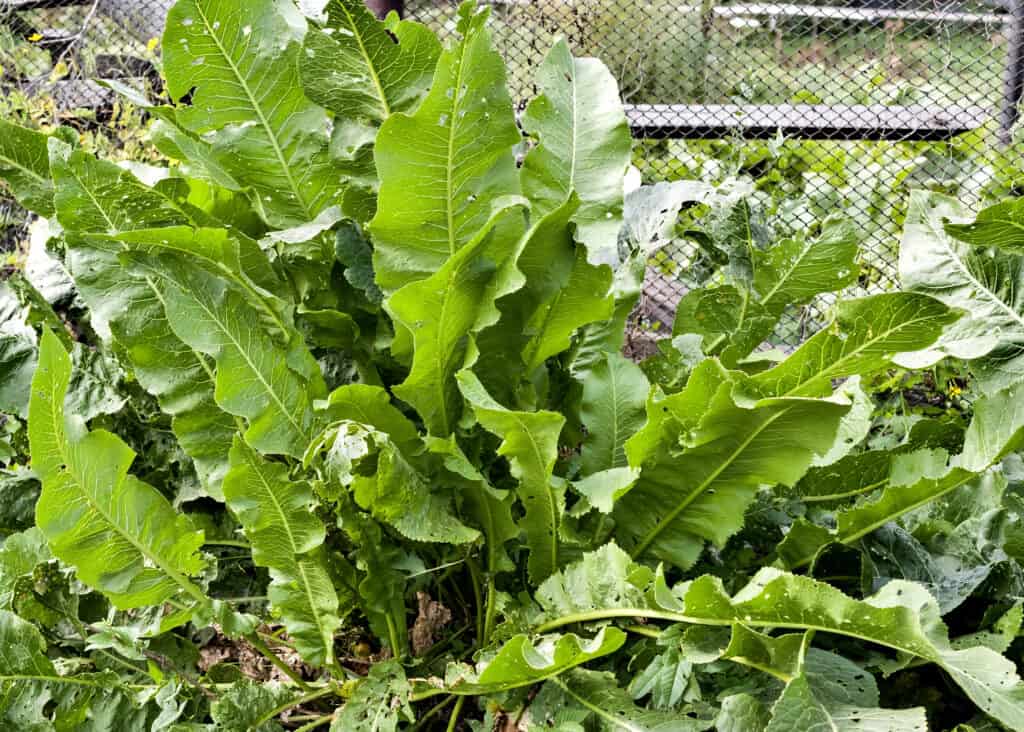
Plant horseradish root cuttings as early as 2 to 6 weeks before the last frost in spring. Horseradish grows best in cool soil, about 40° to 75° (4°-24°C). Set horseradish plants in the garden after the last frost.
Horseradish is cultivated for its pungent flavor. The root is often added to relishes or used dry as a powdered seasoning.
Horseradish is a perennial plant best grown as an annual. Horseradish roots are usually tough and fibrous in the second year and not as flavorful as those newly grown.
Here is your complete guide to growing horseradish!
Growing horseradish as an annual
Horseradish has a spreading habit and can become a weed if left unchecked; the roots spread underground. The best method to keep horseradish under control is to dig it up every autumn; this will keep the roots from spreading. Plants started anew from root cuttings each spring will be more flavorful than those that remain in the garden year after year.
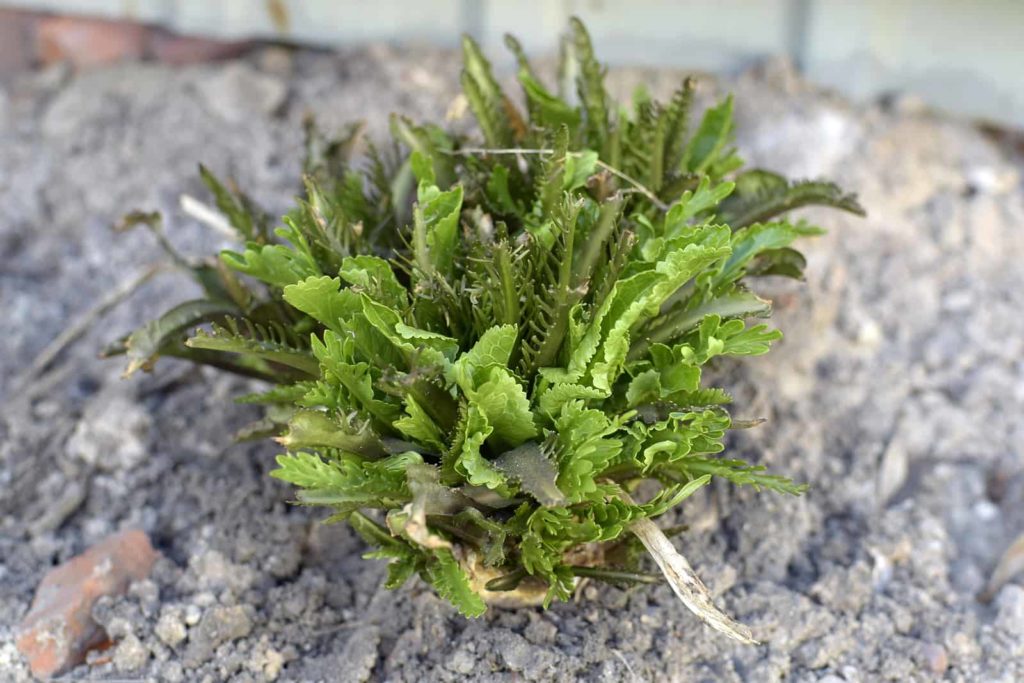
Where to plant horseradish
Start horseradish early in spring. Plant root cuttings or “thongs” that are about 8 inches (20cm) long. Make holes for each root section by pushing a dibble into the soil at an angle of 45 degrees. Push the thinner end of the root into the soil first; cover the root with 2 to 3 inches (5-7.5cm) of soil.
Plant horseradish in humus-rich, well-turned soil; this will permit easy digging of roots at harvest.
Lift all of the roots in autumn before the first freeze. The smaller roots “thongs” can be stored in sand through winter for planting in a new bed in spring. Store the larger roots for use as needed.
- Plant horseradish in full sun; it will tolerate light shade.
- Grow horseradish in rich well-drained soil.
- Prepare the soil to a depth of 10 to 12 inches (25-30cm) and remove stones and lumps that might cause the roots to split.
- Horseradish grows best in rich organic soil. Add aged compost to the planting bed to keep the soil loose. Add sand and compost if the soil is heavy with clay.
- Horseradish prefers a soil pH of 5.5 to 6.8. A soil test will tell you the soil’s pH.
- Allow 1 plant per household
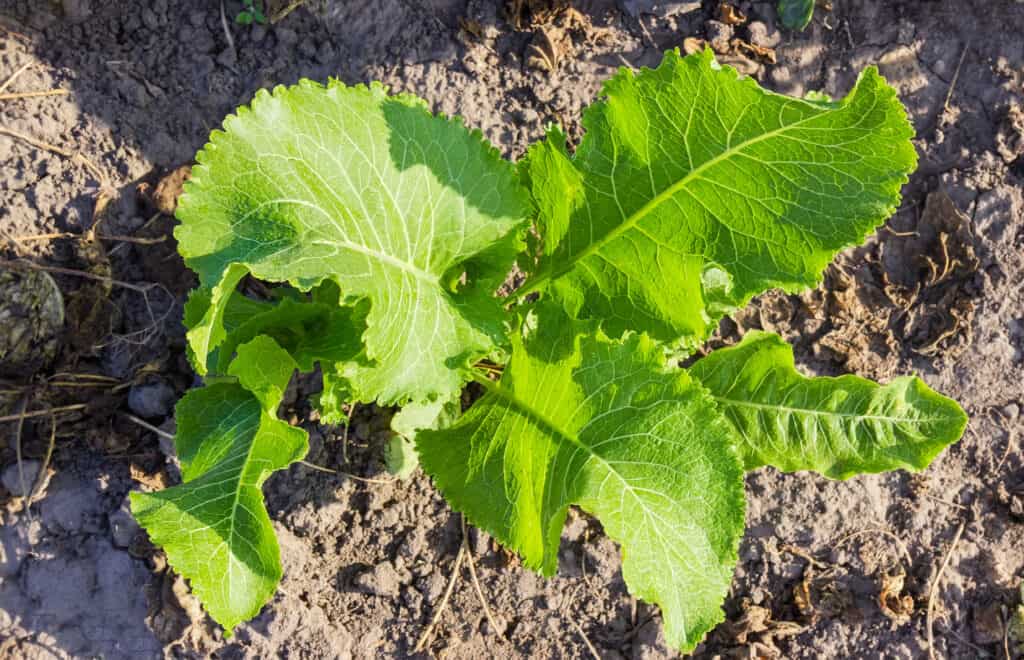
Horseradish planting time
- Horseradish is a cold-hardy plant.
- Set out crowns or root cuttings 4 to 6 weeks before the average last frost date in your region.
- Horseradish grows best in cool, moist regions where the temperature stays between 45°F and 75°F (7-24°C).
Horseradish planting dates
(These dates are for the Northern Hemisphere)
| Average date of the last frost | Planting dates |
| Jan. 30 | Late summer plant |
| Feb. 8 | Late summer plant |
| Feb. 18 | Jan. 15-Feb. 1 |
| Feb. 28 | Jan. 15-Feb. 15 |
| Mar. 10 | Jan. 15-Mar. 1 |
| Mar. 20 | Feb. 15-Mar. 15 |
| Mar. 30 | Mar. 1-Apr. 10 |
| Apr. 10 | Mar. 10-Apr. 10 |
| Apr. 20 | Mar. 20- Apr. 20 |
| Apr. 30 | Apr. 1-May 1 |
| May 10 | Apr. 15-May 15 |
| May 20 | May 1-20 |
| May 30 | May 10-June 1 |
| June 10 | May 20-June 10 |
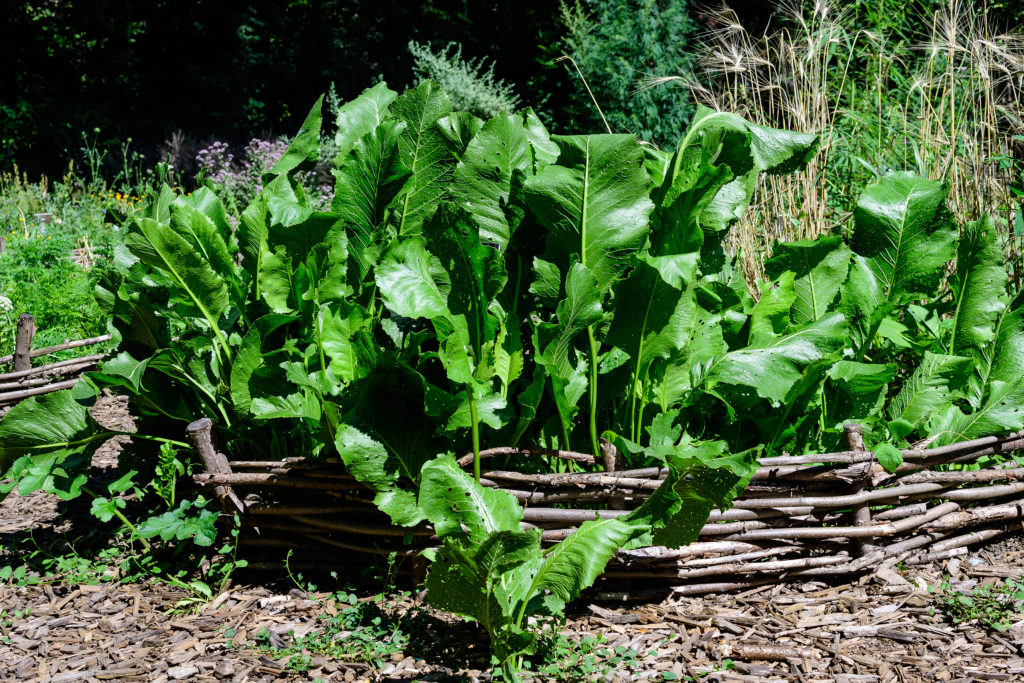
Planting and spacing horseradish
- Set crowns just at the soil level. Plant roots in shallow trenches 3 to 4 inches (7-10cm) deep and cover with 2 to 3 inches (5-7cm) of soil.
- Slice root cuttings at a 30-degree angle or plant with the narrow end down; fill the trench until the wide end of the root is just covered. Space roots 24 to 36 inches (61-91cm) apart.
- Horseradish planted in the garden should be contained with wooden, metal, or masonry borders set at least 24 inches (61cm) deep around the bed.
Horseradish companion plants
- Grow horseradish with potatoes and yams.
Container growing horseradish
- Choose a container that will allow horseradish roots to grow 24 to 30 inches (61-76cm) deep.
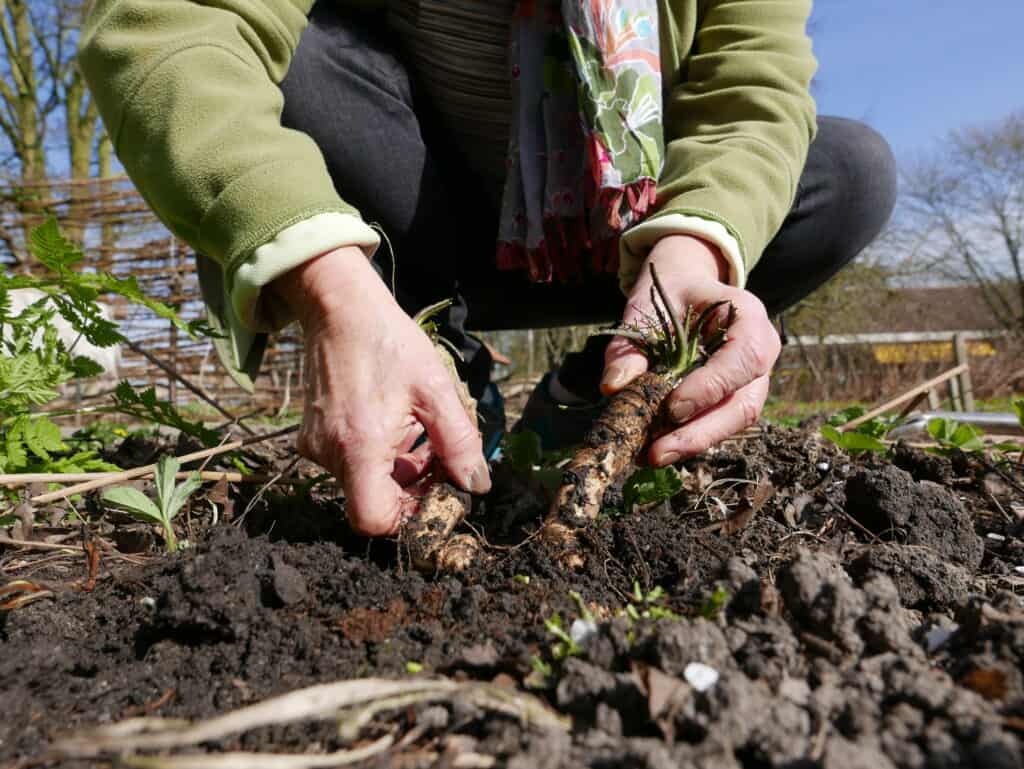
Water and feeding horseradish
- Keep the soil evenly moist to prevent roots from drying and turning woody.
- Fertilize horseradish by adding organic compost to the planting bed every month.
Caring for horseradish
- To grow a large taproot root use a spade to slice down around the plant 3 to 4 inches (7-10cm) from the base pruning away side roots.
- Avoid leaving pieces of the root in the ground after harvest, they will produce a new plant the next year.
Horseradish pests and diseases
- Horseradish has no serious pest problems.
- Horseradish has no serious disease problems
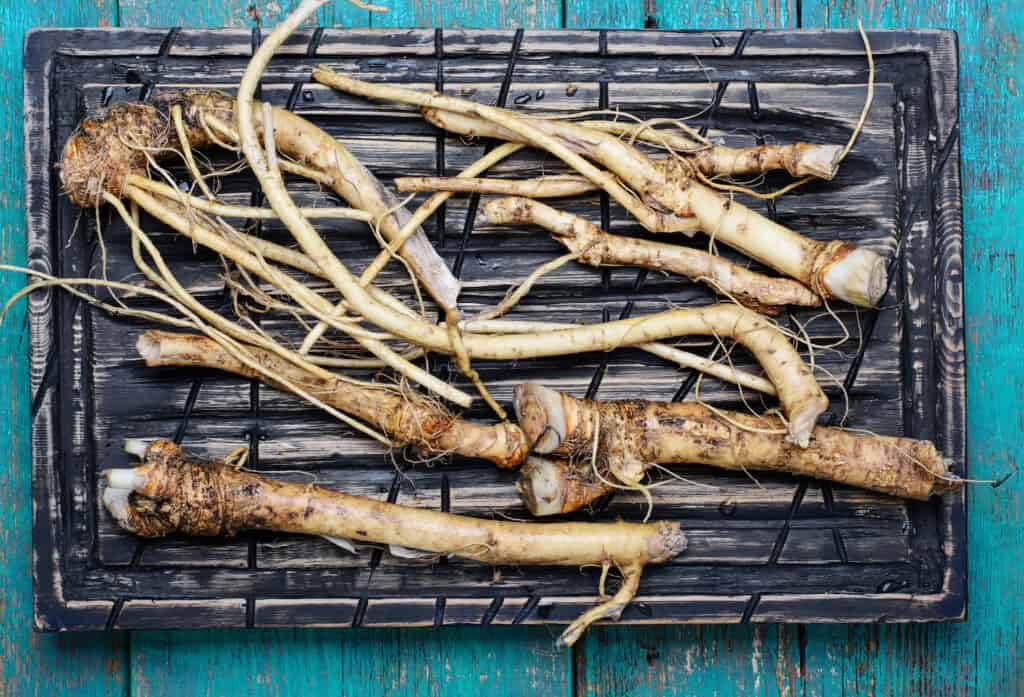
Harvesting horseradish
- Cut sections of root with a sharp knife for use as needed after leaves are about 12 inches (30cm) long (roots will then be 3 to 4 inches/7-10cm in diameter).
- Horseradish makes its best growth in late summer and fall, so delay harvesting until mid-autumn or later.
- Harvest all roots before the ground freezes otherwise new plants will spring up the following year.
Storing and preserving horseradish
- Trimmed and washed horseradish roots can be stored in a glass jar or plastic bag for two weeks after harvest in the refrigerator.
- Grated horseradish can be kept in a glass jar or airtight container in the refrigerator for one to two weeks.
- Whole unwashed roots can be packed in damp sawdust and kept for up to 10 months. This is the best way to preserve the roots’ pungency if roots are not going to be used soon after harvest.
- To freeze horseradish, grate the roots and mix them with vinegar and water.
Horseradish kitchen use
- Horseradish can be used fresh or pickled as a condiment or in sauces.
- Fresh horseradish can be grated, diced, julienned, or sliced. Use an inch or two at one time, just peel the section you will be using fresh.
- Add lemon juice to freshly sliced roots.
Horseradish varieties to grow
- Horseradish is non-varietal.
About horseradish
- Common name. Horseradish
- Botanical name. Armoracia rusticana
- Origin. Eastern Europe
Horseradish articles at Harvest to Table:
How to Plant, Grow, and Harvest Horseradish
Seven Ways to Prepare Horseradish
More how to grow articles:
Learn how to plant, grow, and harvest your favorite vegetables. Click below for all you need to know.
- Artichoke
- Arugula
- Asparagus
- Beans, Snap
- Beets
- Broad Beans
- Broccoli
- Brussels Sprouts
- Cabbage
- Cantaloupe — Melons
- Cardoon
- Carrots
- Cauliflower
- Celeriac
- Celery
- Chard
- Chayote Squash
- Chickpeas
- Chicory
- Chinese Cabbage
- Collards
- Corn Salad
- Corn, Sweet
- Cresses
- Cucumbers
- Eggplant
- Endive and Escarole
- Fava Beans
- Florence Fennel
- Garbanzo Beans
- Garlic
- Horseradish
- Jerusalem Artichoke
- Kale
- Kohlrabi
- Leeks
- Lettuce
- Lima Beans
- Melons
- Mizuna
- Mustard Greens
- New Zealand Spinach
- Okra
- Onions
- Parsnips
- Peanuts
- Peas
- Peppers
- Potatoes
- Pumpkins
- Radicchio
- Radishes
- Rhubarb
- Rutabaga
- Salsify
- Shallots
- Sorrel
- Southern Peas
- Soybeans
- Spinach
- Squash, Summer
- Squash, Winter
- Sunchokes
- Sweet Potato
- Swiss Chard
- Taro
- Tomatillo
- Tomatoes
- Turnips
- Watermelon
- Zucchini
Grow 80 vegetables: THE KITCHEN GARDEN GROWERS GUIDE
Garden Planning Books at Amazon:
- Vegetable Garden Almanac & Planner
- Kitchen Garden Grower’s Guide Vegetable Encyclopedia
- Vegetable Garden Grower’s Guide
- Tomato Grower’s Answer Book



